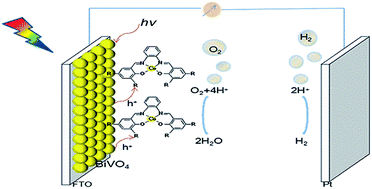当前位置:
X-MOL 学术
›
J. Mater. Chem. A
›
论文详情
Our official English website, www.x-mol.net, welcomes your
feedback! (Note: you will need to create a separate account there.)
Molecular cobalt salophen catalyst-integrated BiVO4 as stable and robust photoanodes for photoelectrochemical water splitting†
Journal of Materials Chemistry A ( IF 10.7 ) Pub Date : 2018-05-02 00:00:00 , DOI: 10.1039/c8ta01304g Yidan Liu 1, 2, 3, 4 , Yi Jiang 1, 2, 3, 4 , Fei Li 4, 5, 6, 7 , Fengshou Yu 4, 5, 6, 7 , Wenchao Jiang 1, 2, 3, 4 , Lixin Xia 1, 2, 3, 4
Journal of Materials Chemistry A ( IF 10.7 ) Pub Date : 2018-05-02 00:00:00 , DOI: 10.1039/c8ta01304g Yidan Liu 1, 2, 3, 4 , Yi Jiang 1, 2, 3, 4 , Fei Li 4, 5, 6, 7 , Fengshou Yu 4, 5, 6, 7 , Wenchao Jiang 1, 2, 3, 4 , Lixin Xia 1, 2, 3, 4
Affiliation

|
Photoelectrochemical (PEC) water splitting is a promising method for the conversion and storage of solar energy. A combination of catalysts with photoelectrodes is generally required for the development of active photoanodes in PEC devices. In this work, we present two BiVO4 photoanodes modified with cobalt salophen (Co(salophen)) complexes for PEC water oxidation. The resulting photoanodes show significantly enhanced PEC performance. Under simulated sunlight illumination (AM 1.5G, 100 mW cm−2), high photocurrents of 3.89 mA cm−2 and 4.27 mA cm−2 were obtained for Co1/BiVO4 and Co2/BiVO4, respectively at 1.23 V (vs. the reversible hydrogen electrode (RHE)) in a neutral solution, an almost three-fold enhancement over that of the unmodified BiVO4. Intensity-modulated photocurrent spectroscopy (IMPS) analysis shows that the Co(salophen) complexes not only accelerate the water oxidation reaction but also reduce the surface recombination. The half-cell solar energy conversion efficiencies for Co1/BiVO4 and Co2/BiVO4 were 1.09% and 1.18% at 0.7 V, respectively. Due to their hydrophobic nature, the Co(salophen) complexes can bind strongly to the surface of BiVO4. When the Co2 complex featuring four hydrophobic tert-butyl groups in a salophen ligand was anchored to BiVO4, an extremely stable photocurrent of more than 3.5 mA cm−2 at 1.23 V vs. RHE is sustained for at least 3 h without decay. Such a stable and robust photoanode based on a molecular WOC surpasses those attained by most of the state-of-the-art heterogeneous catalysts.
中文翻译:

分子钴盐酚催化剂集成的BiVO 4作为稳定而坚固的光阳极,用于光电化学水分解†
光电化学(PEC)分解水是一种有前途的太阳能转化和存储方法。在PEC器件中开发活性光阳极通常需要催化剂与光电极的组合。在这项工作中,我们介绍了两个用PEO水氧化用钴Salophen(Co(salophen))配合物修饰的BiVO 4光阳极。所得的光阳极显示出显着增强的PEC性能。下模拟太阳光照射(AM 1.5G,100毫瓦厘米-2),的3.89毫安厘米高的光电流-2和4.27毫安厘米-2分别为CO1 / BiVO得到4和CO 2 / BiVO 4在1.23 V(分别对中性溶液中的可逆氢电极(RHE),比未修饰的BiVO 4几乎提高了三倍。强度调制的光电流能谱(IMPS)分析表明,Co(salophen)配合物不仅加速了水的氧化反应,而且减少了表面的重组。在0.7 V时,Co1 / BiVO 4和Co2 / BiVO 4的半电池太阳能转换效率分别为1.09%和1.18%。由于其疏水性,Co(salophen)配合物可以牢固地结合到BiVO 4的表面。当在Salophen配体中具有四个疏水叔丁基的Co2配合物锚定在BiVO 4上,在1.23 V vs. RHE的情况下,超过3.5 mA cm -2的极其稳定的光电流可维持至少3 h,而不会衰减。这种基于分子WOC的稳定而坚固的光阳极超过了大多数最新技术的非均相催化剂所获得的光阳极。
更新日期:2018-05-02
中文翻译:

分子钴盐酚催化剂集成的BiVO 4作为稳定而坚固的光阳极,用于光电化学水分解†
光电化学(PEC)分解水是一种有前途的太阳能转化和存储方法。在PEC器件中开发活性光阳极通常需要催化剂与光电极的组合。在这项工作中,我们介绍了两个用PEO水氧化用钴Salophen(Co(salophen))配合物修饰的BiVO 4光阳极。所得的光阳极显示出显着增强的PEC性能。下模拟太阳光照射(AM 1.5G,100毫瓦厘米-2),的3.89毫安厘米高的光电流-2和4.27毫安厘米-2分别为CO1 / BiVO得到4和CO 2 / BiVO 4在1.23 V(分别对中性溶液中的可逆氢电极(RHE),比未修饰的BiVO 4几乎提高了三倍。强度调制的光电流能谱(IMPS)分析表明,Co(salophen)配合物不仅加速了水的氧化反应,而且减少了表面的重组。在0.7 V时,Co1 / BiVO 4和Co2 / BiVO 4的半电池太阳能转换效率分别为1.09%和1.18%。由于其疏水性,Co(salophen)配合物可以牢固地结合到BiVO 4的表面。当在Salophen配体中具有四个疏水叔丁基的Co2配合物锚定在BiVO 4上,在1.23 V vs. RHE的情况下,超过3.5 mA cm -2的极其稳定的光电流可维持至少3 h,而不会衰减。这种基于分子WOC的稳定而坚固的光阳极超过了大多数最新技术的非均相催化剂所获得的光阳极。











































 京公网安备 11010802027423号
京公网安备 11010802027423号